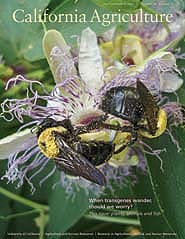All Issues

When transgenes wander, should we worry? This issue: plants, animals, and fish
Cover:
Pollen-coated bees on a passion flower. Pollination is one of the ways that transgenic crops can hybridize with other crops and native plants. (No transgenic passion flowers have been field-tested in California.) Photo by Howard Creech .
July-September 2006
Volume 60, Number 3
Volume 60, Number 3





